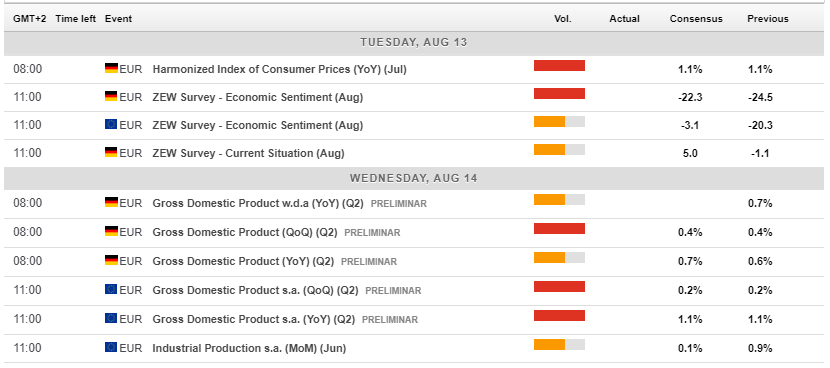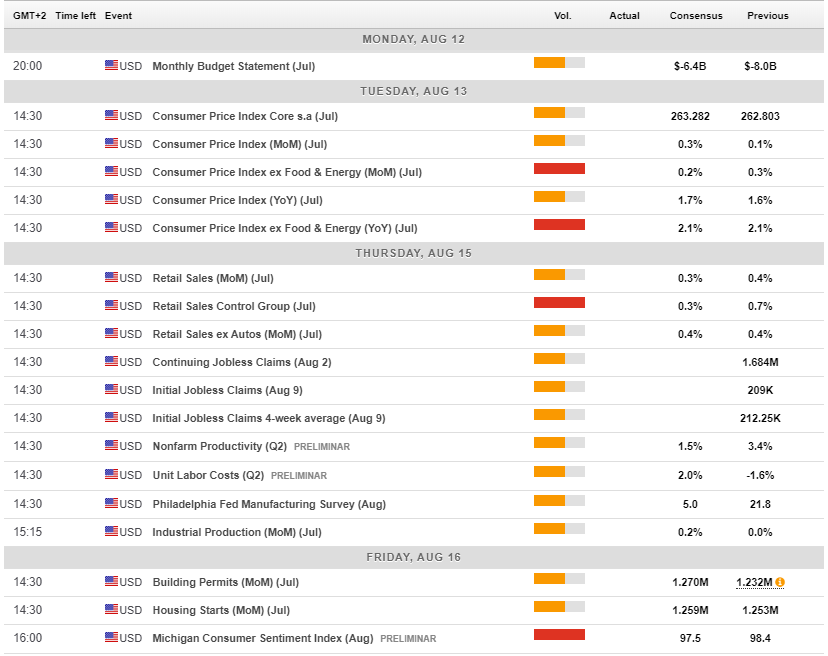- EUR/USD has recovered thanks to the dollar’s weakness.
- Updated euro-zone GDP, the US consumer, and trade are eyed.
- Mid-August’s daily chart is pointing to fresh falls for the pair.
“When two are fighting, the third wins” – goes the saying. The euro has benefited from the intensifying US-Sino trade spat. China has devalued its yuan and triggered a rush to safety that weighed on the USD. Will this continue? Back in the euro-zone, updated GDP data, a German business survey, and Italy’s political issues will compete for attention with the US consumer.
What just happened: Trade troubles counter German weakness
The first full week of the summer month of August has been nothing but calm. The People’s Bank of China allowed has allowed markets to push the yuan to new lows, with USD/CNY breaching the round 7.00 levels. The Asian giant’s readiness to use its currency to counter American tariffs has rattled markets. Stock markets have tumbled, and investors fled to the safety of bonds.
The consequent fall in the benchmark 10-year US Treasury yields to below 1.60% – to the lowest since October 2016 – reflects growing expectations for an imminent rate cut. Bond markets are now indicating a 100% certainty that the Federal Reserve will cut rates by 25 basis points again ni September – and even a chance of a 50bp reduction.
And in turn, the rising chances of a Fed cut have weighed on the greenback, allowing EUR/USD to recover. Officials from the central bank have sent mostly dovish messages. Lael Brainard, a Fed Governor, has said that she sees monitoring events closely. James Bullard, of the Saint Louis Fed, has said that he envisions one more rate cut this year. However, he does not favor reacting to every tit-for-tat action in the trade war. Charles Evans, President of the Chicago branch, has opened the door to cutting rates, while Esther George of the Kansas branch has expressed content with the current rate.
The greenback has also been pressured by the weak ISM Non-Manufacturing Purchasing Managers’ Index (PMI) which missed with 53.7 points – indicating a slowdown also in the services sector.
Contrary to Draghi’s drag on the euro two weeks ago, the euro has been left with few defenses – or few downbeat economic figures – to push it lower in this race to the bottom.
The few economic data points that have been released came out mixed. German factory orders surprised with a rise of 2.5% – above expectations – while industrial output slipped by 1.5%.
While German data has already been worse, it is becoming clear that the locomotive of the euro-zone has been suffering a significant slowdown. Pressure on Berlin to open its purse strings is mounting. And perhaps the guardians of fiscal discipline are beginning to change their minds – reports suggest that the government is mulling extraordinary expenditure to battle the climate crisis. If Chancellor Angela Merkel and her colleagues signal new investment is coming, it could boost not only the local economy but also the European and even the global one.
Italian politics have returned to the limelight as interior minister Matteo Salvini – considered the de-facto PM – is reportedly planning to break up the government and head to the polls. His The League party has won the recent EU elections and has been clashing with the 5-Star Movement – the embattled coalition partner. Politicians may defy EU budget restraints and may promise to significant deficits in the election campaign. Italy is the euro area’s third-largest economy, and its clash with Brussels in late 2018 weighed on the euro.
Euro-zone events: GDP updates and Italian politics stand out
German data stands out on Tuesday with the release of the final German inflation figures and – more importantly – the updated ZEW business survey for August. July’s numbers have been in the red – indicating worsening economic conditions now and pessimism about future growth. Similar figures are projected for the current month.
The zone’s largest economy stands out also on Wednesday with the first release of its Gross Domestic Product for the second quarter. Recent downbeat data open the door to slower growth. The euro-zone will later release updated GDP data for the whole euro-zone expectations. The German figures will shape expectations.
Italian politics – which have been unable to impact the euro – may take center stage now. A full-blown crisis and setting a date for new elections may send the common currency lower. A defusion of tension may support it.
Another factor to keep an eye on is Brexit. The growing chances of a no-deal UK exit from the EU have sent sterling plunging but have yet to affect the euro. If fears mount, the euro may move.
Here are the events lined up in the euro-zone on the forex calendar:
US events: Trade wars and the consumer in focus
The US-Sino trade war – which has also turned into a currency war – will likely dominate markets once again. The PBOC’s yuan fixing will probably be in the limelight, and so will rhetoric from both Beijing and Washington. Any positive development regarding the resumption of trade talks may improve sentiment and push the dollar higher. A lower value of the yuan and angry comments may weigh on bond yields and the greenback.
For the Federal Reserve, the next moves also depend on the data – and this week’s figures are consumer-centric. The Consumer Price Index (CPI) for July is due out on Tuesday and economists project stability – the all-important Core CPI carries expectations of repeating the 2.1% annual rise. The central bank would like to see a pick up in underlying inflation.
The main release of the week is on Thursday – retail sales for July. Relatively modest increases in consumption are on the cards after robust rises in June when the control group – considered the “core of the core” – leaped by 0.7%. Consumption remains the economy’s strong point, while investment is dropping. The Fed and markets would like to see the American shopper extend its shopping spree.
The US also releases preliminary unit labor costs for the second quarter on Thursday – another gauge of inflation – as well as industrial output. Nevertheless, retail sales will likely overshadow these additional releases.
Friday features building permits and housing starts – which have been stable of late – but the last word of the week belongs to the consumer. The University of Michigan’s initial Consumer Sentiment figure for August is forecast to tick down but remain at high levels. Any deviation may set the tone for the week’s close.
EUR/USD Technical Analysis
EUR/USD is suffering from downside momentum on the daily chart and has failed in its attempts to break above the 50 and 100-day Simple Moving Averages. The pair also remains below the 200 SMA.
Overall, bears are in control.
1.1180 provides some support after limiting the falls in August and also in mid-June. A more significant cushion awaits at 1.1165, which capped EUR/USD in early August. 1.1145 is a weak support line that worked as such in May. The former double-bottom of 1.1110 held it up twice in April and then in May. The next line is critical – the 2019 trough at 1.1027. The following line is 1.0900.
Some resistance awaits at 1.1250, which is the highest level in August so far. The triple-top of 1.1285, which has limited held EUR/USD down in mid-July is next. 1.1325 was the high point in April, and it is followed by 1.1345 that worked as both support and resistance in May. Next, we find 1.1390 and 1.1410.
EUR/USD Sentiment
The euro may have limited room to continue gaining as the world’s largest economies clash. The euro-zone economies are set to suffer from a global slowdown, and recent EZ economic data has been disappointing. There is more scope for falls than rises for the pair.


-637009369090958374.png)
